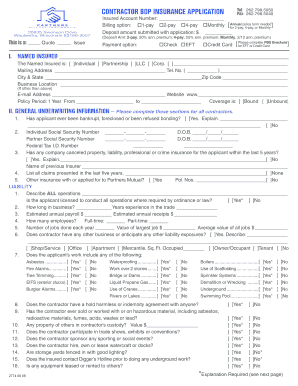Fill and Sign the Business Insurance Application Form

Practical advice on setting up your ‘Business Insurance Application’ online
Are you fed up with the burden of managing documents? Look no further than airSlate SignNow, the leading eSignature platform for individuals and businesses. Bid farewell to the lengthy procedure of printing and scanning files. With airSlate SignNow, you can effortlessly finalize and endorse documents online. Take advantage of the powerful tools integrated into this intuitive and cost-effective platform and transform your method of document management. Whether you need to sign forms or collect eSignatures, airSlate SignNow simplifies the process with just a few clicks.
Adhere to this detailed guide:
- Access your account or initiate a free trial with our service.
- Click +Create to upload a file from your device, cloud storage, or our form repository.
- Open your ‘Business Insurance Application’ in the editor.
- Click Me (Fill Out Now) to finalize the document on your end.
- Insert and designate fillable fields for others (if needed).
- Proceed with the Send Invite options to request eSignatures from others.
- Download, print your version, or convert it into a reusable template.
No need to worry if you need to collaborate with others on your Business Insurance Application or send it for notarization—our solution provides you with everything necessary to accomplish such tasks. Sign up with airSlate SignNow today and elevate your document management to an enhanced level!
FAQs
-
What is a Business Insurance Application?
A Business Insurance Application is a formal request to obtain insurance coverage for your business. It typically includes essential details about your company, such as its size, industry, and specific coverage needs. Using airSlate SignNow, you can easily complete and eSign your Business Insurance Application electronically, streamlining the entire process.
-
How does airSlate SignNow simplify the Business Insurance Application process?
airSlate SignNow simplifies the Business Insurance Application process by allowing you to fill out, sign, and send documents online in just a few clicks. The platform's intuitive interface ensures that you can easily navigate through the application, reducing the time spent on paperwork. Plus, electronic signatures are legally binding, making your Business Insurance Application valid and secure.
-
Is airSlate SignNow cost-effective for managing Business Insurance Applications?
Yes, airSlate SignNow offers a cost-effective solution for managing Business Insurance Applications. With flexible pricing plans, businesses of all sizes can find an option that fits their budget. The savings on paper, printing, and mailing costs, combined with increased efficiency, make using airSlate SignNow a smart financial choice.
-
What features does airSlate SignNow offer for completing a Business Insurance Application?
When using airSlate SignNow for your Business Insurance Application, you benefit from features like customizable templates, in-app collaboration, and secure cloud storage. Additionally, the platform supports various document formats and integrates seamlessly with other tools, ensuring a smooth experience from start to finish.
-
Can I track the status of my Business Insurance Application with airSlate SignNow?
Absolutely! airSlate SignNow allows you to track the status of your Business Insurance Application in real-time. You can see when the document has been viewed, signed, or completed, which helps you stay organized and informed throughout the application process.
-
Does airSlate SignNow integrate with other business tools for managing Business Insurance Applications?
Yes, airSlate SignNow integrates with various business tools such as CRM systems, project management software, and cloud storage services. This integration capability enables you to streamline your workflow and manage your Business Insurance Application seamlessly alongside other essential business operations.
-
What are the benefits of using airSlate SignNow for Business Insurance Applications?
The benefits of using airSlate SignNow for Business Insurance Applications include increased efficiency, reduced paperwork, and enhanced security. The platform allows for quick eSigning and document sharing, which accelerates the application process and ensures that your sensitive information is protected.
Related searches to business insurance application form
Find out other business insurance application form
- Close deals faster
- Improve productivity
- Delight customers
- Increase revenue
- Save time & money
- Reduce payment cycles

